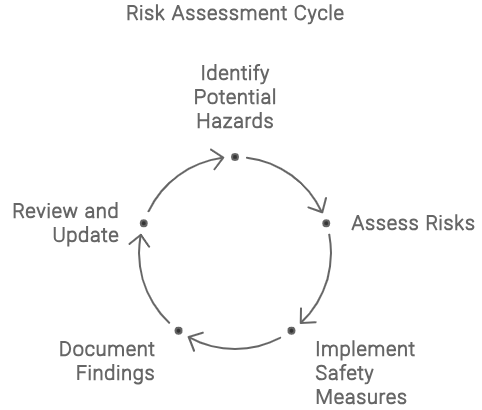The 5 Main Steps of Risk Assessment Explained for Kids

Risk assessment helps you stay safe by determining potential dangers and their likelihood of happening. It’s like a superpower for making smart choices. Here are five simple steps to learn how to assess risks and make safe decisions in your everyday life. Let’s dive in and discover the exciting world of risk assessment!
What Is Risk Assessment?
Identifying potential hazards and dangers in a risk assessment involves various techniques. These may include site inspections, reviewing incident reports, and consulting with employees.
When assessing potential at-risk individuals, it’s essential to evaluate those carrying out the activity and others who might be affected, such as bystanders or visitors.
The process for determining and implementing safety measures based on assessed risks includes evaluating the risks and deciding on precautions. Tools like the free risk assessment calculator can help assess and prioritize risk levels.
Recording significant findings, including hazard identification and control measures, is crucial for any organization, regardless of size. Periodically reviewing and updating risk assessments is critical to account for changes in the workplace.
Getting Ready for Risk Assessment
Potential dangers need to be identified in preparation for risk assessment. These hazards can cause harm during specific tasks or activities.
Identifying individuals who could potentially be at risk of harm is essential. This includes employees carrying out the task and others who might be affected.
Using a risk assessment calculator can help evaluate risks and prioritize them. Based on the evaluation of risks, safety measures should be chosen. Their aim should be to prevent harm or minimize potential dangers.
Step 1: Finding the Dangers
Potential environmental dangers and hazards can include physical, chemical, and ergonomic hazards.
Physical hazards may involve noise, electricity, or machinery, while chemical hazards could come from cleaning fluids or solvents.
Ergonomic hazards like poor lighting or uncomfortable working positions are also essential to consider.
It’s crucial to evaluate known and potential safety risks, assess who might be harmed and how, and record significant findings.
Efforts should be made to remove risks and implement control measures when complete removal isn’t feasible.
It’s essential to identify and evaluate potential dangers by considering who might be affected, using tools like a risk assessment calculator to prioritize risk levels.
Periodically reviewing risk assessments based on changes in the workplace is also essential.
Step 2: Who Could Get Hurt and How?
Potential hazards can harm people. These hazards include physical, chemical, biological, ergonomic, and psychological risks, such as heavy lifting, exposure to toxic substances, infectious diseases, repetitive motion injuries, and workplace stress.
These hazards can lead to injuries like physical injuries, poisoning, illness, musculoskeletal disorders, and mental health issues.
Individuals could be at risk in specific scenarios such as handling heavy equipment, working with hazardous chemicals, exposure to infectious patients, repetitive manual labor, and dealing with high-pressure or stressful situations.
Step 3: Weighing the Risks and Choosing Safety Measures
Once potential risks have been identified, it is essential to assess how serious they are and what harm they could cause. Safety measures can be implemented to reduce or eliminate these risks. This may involve using protective equipment, following safety procedures, providing training, or changing how work is done. The effectiveness of these safety measures can be checked with regular monitoring and employee feedback.
If the measures aren’t working or new risks arise, changes can be made to keep the workplace safe.
Step 4: Writing Down Important Safety Information
Hazards, potential harm, and control measures are the most important safety measures to document. Safety information should be organized and stored in an easily accessible and understandable way.
For example, a standardized format, like a risk assessment template, can ensure that all critical findings are recorded clearly. This information should be accessible to all employees, especially those directly affected by the hazards.
Employers also need access to this information to make informed decisions about implementing control measures to prevent harm in the workplace.
Step 5: Check and Change the Plan When Needed
The safety plan should be checked for effectiveness, mainly when workplace changes occur. This includes new equipment, procedures, or personnel. Signs that show a need for change in the safety plan include incidents, near-misses, employee feedback, or changes in legislation or industry standards.
To update the safety plan, the organization should reassess hazards, evaluate risks, and determine precautions. It should also record any significant findings, including hazards, potential harm, and control measures, to ensure all information is up-to-date and relevant.

Vizologi is a revolutionary AI-generated business strategy tool that offers its users access to advanced features to create and refine start-up ideas quickly.
It generates limitless business ideas, gains insights on markets and competitors, and automates business plan creation.


